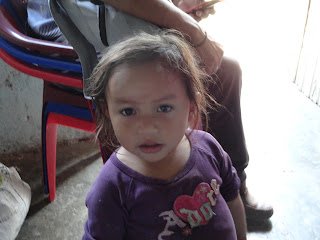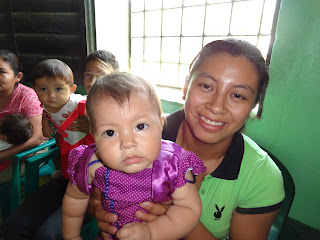I haven't really written much about the parish in the last two weeks and so I want to share a few thoughts on events here.
Friday, June 22, the parish of Dulce Nombre had a dinner
with a guest speaker, a priest who is also a singer from Choluteca. They raised
money for the parish’s kitchen/dining room and meeting hall, which is rapidly
being constructed – despite financial restraints.
 |
| Walls of the second floor are almost finished |
The priest was
a good singer and an animated speaker. I didn’t quite like his style and
found his message a little simplistic. But the people enjoyed it and the meal
was good.
The mornings of June 22 and 23, I spent with leaders of the
base community’s going over the new Catholic Social Teaching booklet they are
using (and that I wrote); I used the meetings to help them improve their meetings, making them
more participative. The leaders were receptive and, in fact, some mentioned that
their style is to promote as much participation as possible. How encouraging in
a culture where people in authority are accustomed to speak AT people for long
periods of time. It was good to be with them.
At the meetings I also spent time doing a little reflection
with them on the parable of the mustard seed, trying to help them relate it to
their lives as campesinos. Perhaps I
was reading more into the parable than is there but I asked them about seeds
and how much time is needed for them to sprout – four days for a mustard seed,
five for corn, four for beans, months for coffee, about a year for noni, and
quite some time for trees. We talked about the need for patience and how
people grow in their faith at different rates. This may help them in dealing
with people who don’t seem to respond to their efforts to evangelize the
people.
Sunday I went to Joyas Galanas. The road there was terrible
and I thought I’d get stuck a few times – but new tires and four wheel drive
low got me through. (I returned by a different route – with a much better road.)
The crowd at the Celebration of the Word was small, but many came to Communion.
 |
| The Joyas Galanas valley |
Friday and Saturday of this week was the training session
for new catechists. Forty-eight showed up – most of them young and most from a
zone of the parish that needs a lot more youth in their ministries. Since it
was a young crowd they were a lot less participative than I’d hope. We treated
the sacraments of Reconciliation and Eucharist.
 |
| Catechists during a small group session |
On Friday I did a session on examination of conscience. I
went through a few ideas but we then spent about half an hour
using the Jesuit examen. It was absolutely amazing the silence in the hall
while we went through five steps. I was very glad to see even the young people taking advantage of silence.
Saturday morning I did a session on the parts of the Mass,
using a sort of jigsaw puzzle approach that I’ve used before. In groups, they
had to arrange the parts of the Mass in order.
I’ve done this before, but this time it was harder for the
groups to do it. I ended up running between the four groups, helping them in
the process. (And so, no pictures.)
Afterwards we reflected on how hard it was for them. They
actually did very well with the Introductory Rites and the Liturgy of the Word
but the Liturgy of the Eucharist was really hard for them. I think this was
partly because I included the official Greek terms (epiklesis, anamnesis). But
I think it was so hard because most of them don’t experience Mass in their
villages very often. They might get to a Mass in their sector or a special
parish Mass but many had Mass in their village only once a year! They are very
familiar with the weekly Sunday Celebrations of the Word and so could identify
the parts of the Introductory Rites and Liturgy of the Word. But lack of access
to Mass made the other parts of the exercise difficult.
I left the catechists with a little booklet with the parts of the
Mass. They were glad to have it and some talked about sharing it with other
ministries in their villages. I urged them to study it with the village church
council, especially before a Mass in their village.
 |
| Sor Pedrina at the Youth Assembly |
After my presentation I hurried back to Santa Rosa with Sor
Pedrina and six young people for the diocesan Youth Encounter. Over a thousand
young people (and some older folks) showed up for the walk from the Catholic
University to the City Gymnasium where Mass was celebrated, followed by a
concert that ended with Benediction. We got there in time for Mass.
 |
| Bishop Romulo Emiliani preaching |
Three bishops and about 8 priests concelebrated. Bishop
Romulo Emiliani, the auxiliary bishop of SanPedro Sula, preached on the problem
of violence and the need to turn to Christ. He’s quite the orator and the
message was quite good – talking about the roots of violence in consumption,
materialism, and more. He did speak a bit about corruption and other social problems
of the country, including the 42% of infants with chronic malnutrition. I wish
he had been more specific in his homily about the social and political roots of
the violence here, since this was a Mass for Peace in the face of violence. But
it was good.
After a lunch break there were warm up acts for the main
event “Son by 4,” a Puerto Rican music group. Their singing was quite good, but I was left hungering for something more.
 |
| Son by 4 in concert; note all the cellphone cameras |
The music was spirited. But at one point I felt that I was at a
rock concert, with phone cameras going wild and people clapping and singing.
The lyrics, as far as I could understand, were very
individualistic. They shared stories of their group and of a conversion they’d
witnessed.
The lack of a social context left me wondering.
The event cost 100 lempiras - $5.00, which is a lot for people from the
countryside. About a third of the
group were Catholic University students, who are mostly middle class and
upwardly mobile.
But I didn’t hear anything in the group’s songs about the
poor. Love of God, yes – but love of the neighbor and a commitment to the poor
didn’t come through to me. (Maybe I missed it, since sung lyrics are often hard
to understand.)
I know some of the young people from other parishes were
poor and others, including a group of five friends, do have a sense of care for
the poor.
 |
| Bishop Andino carrying the Eucharist in procession |
I left at the end of Benediction. Bishop Darwin came back
and carried the monstrance with the consecrated Host through the crowd and
placed it in front of a statue of Mary.
 |
| Monstrance with consecrated host before statue of Mary |
The group sang several of its songs but what struck me was
the image of the monstrance in front of Mary. It was, as a friend noted of the
photo, “iconic.” The monstrance was placed in front of the statue in such a way that it appeared to be just in
front of Mary’s womb – where some icons place Jesus.
I was struck by this image as we knelt in
adoration of Christ in the Eucharist.
I left and went
home – to a noisy neighbor playing music at an incredible volume. I went
and asked them to turn it down and they did!
Reflecting back on the last week, I find again that I feel
myself most at home with the poor – even at their celebrations with poor music. Their
wisdom and piety nurture my soul.
The hype of the concert and its individualistic message left
me cold – though the piety of young people kneeling in prayer continues to
inspire me (as it inspired me during my 24 years in campus ministry at St.
Thomas in Ames.)
There is hope – though it is a long struggle to lessen
violence here. I don’t think it
will come through concerts or a lot of large meetings. It may come with the
work of people in their communities, with small groups working and praying
together.
Also, work on alternatives is important. And the parish of
Dulce Nombre de María is planning to host a workshop in late July.
---
More photos of the Diocesan Youth Encounter can be found here.
---
More photos of the Diocesan Youth Encounter can be found here.





























